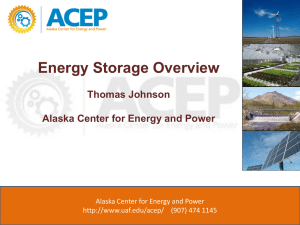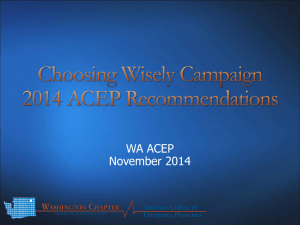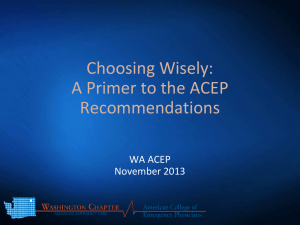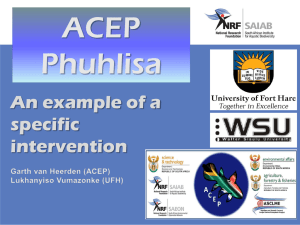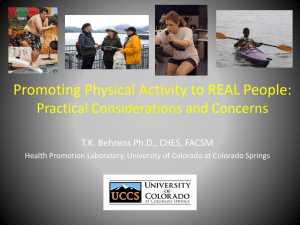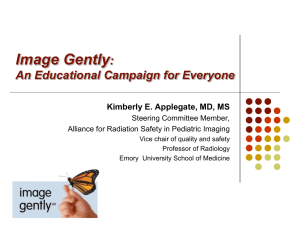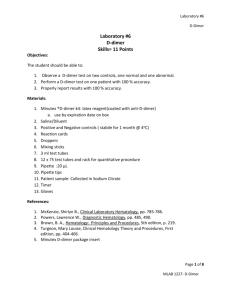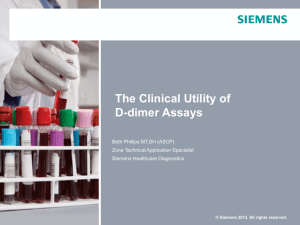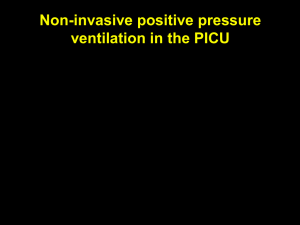ACEP and Essentials 2014
advertisement
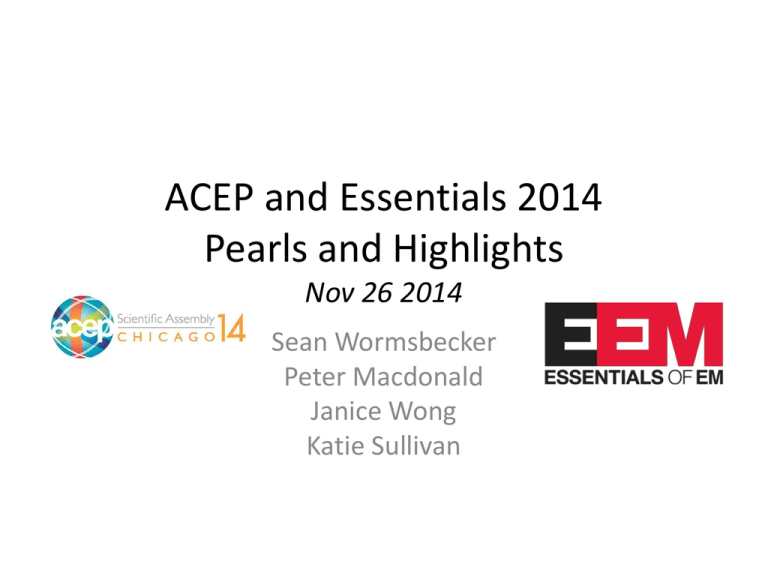
ACEP and Essentials 2014 Pearls and Highlights Nov 26 2014 Sean Wormsbecker Peter Macdonald Janice Wong Katie Sullivan Strictly an overview... • Brief synopses of interesting topics • Not comprehensive reviews of topics • Generate discussion and interest for future rounds Essentials Pearls Sean Wormsbecker Topical Tetracaine in Corneal Abrasions • 1: Topical tetracaine used for 24 hours is safe and rated highly effective by patients for the treatment of pain caused by corneal abrasions: a double-blind, randomized clinical trial. Waldman N, Densie IK, Herbison P. Acad Emerg Med. 2014 Apr;21(4):374-82 • RCT of 122 patients with simple corneal abrasions on slit lamp • No difference in healing (uptake of fluorescein on repeat exam) • Similar pain scoring, but treatment group reported better “effectiveness of treatment” Topical Tetracaine in Corneal Abrasions • Ready for primetime? – Small study – No contrary evidence of harm • What do our colleagues say? Post-Arrest Cooling • Targeted temperature management at 33°C versus 36°C after cardiac arrest. Nielsen N, Wetterslev J, Cronberg T et al. NEJM. 2013 Dec 5;369(23):2197-206 • Multicentre RCT of 950 patients randomized to tight temperature control of 33°C versus 36°C • Primary outcome all cause mortality at six months • Secondary outcome modified Rankin score >=4 at six months • No significant difference Post-Arrest Cooling • Perhaps focus less on the number, more on the process – Criticism of original data was lack of protocolization of care in control arm, poor fever control • Again, what do our colleagues say? Age-Adjusted D-Dimer in PE • Age-adjusted D-dimer cutoff levels to rule out pulmonary embolism: the ADJUST-PE study. Righini M, Van Es J, Den Exter PL et al. JAMA. 2014 Mar 19;311(11):1117-24 • Multicentre prospective validation of using age x 10 as a cutoff for ruling out PE in Wells Criteria low risk patients • 3346 patients enrolled over 3 years, of which 87% were low risk, of which 28% were <500, 11% were age-adjusted negative • 1/810 (0.1%) nonfatal PE in <500, 1/337 (0.3%) nonfatal PE in age-adjusted, 7/1481 (0.5%) still had PE or DVT with negative CTPA (!) Age-Adjusted D-Dimer in PE • Authors felt most applicable to patients >75, as this group is most likely to have a false positive d-dimer at <500 • Application of age adjustment increased negative d-dimer from 6.6% to 29.7% with no additional misses in this group Etomidate and Sepsis • Single-dose etomidate is not associated with increased mortality in ICU patients with sepsis: analysis of a large electronic ICU database. McPhee LC, Badawi O, Fraser GL et al. Crit Care Med. 2013 Mar;41(3):774-83 • Retrospective Database study of 750 000 patients • Sought out septic patients intubated in the ICU (not ED) • N= 2,014: Single dose etomidate = 1,102 and no etomidate = 912 • Attempted matching age, comorbidities, but etomidate arm actually sicker • No difference in mortality Etomidate and Sepsis • Is this relevant to us? – Why use instead of ketamine? • What do our colleagues say? Tranexamic Acid and Epistaxis • A new and rapid method for epistaxis treatment using injectable form of tranexamic acid topically: a randomized controlled trial. Zahed R, Moharamzadeh P, Alizadeharasi S et al. Am J Emerg Med. 2013 Sep;31(9):1389-92. • N=216, 15 cm cotton pledget was soaked in the IV form of TXA (500mg in 5ml) and inserted in the bleeding nares (no formal packing) versus formal packing with pledgets soaked in epi and lidocaine • 71% of the TXA vs. 31% of the nasal packing group stopped bleeding by 10 minutes (OR 2.3, p<0.001) • Rebleeding was less common in the TXA group (4.7% vs. 12.8% at 24 hours and 2.8% vs. 11.0% at 7 days) • Time to discharge and ED complications also favored the TXA group Tranexamic Acid and Epistaxis • Apples and Oranges? – We use rapid rhino, not conventional packs • Consider as adjunct? Preoxygenation and RSI • Weingart, Scott D., and Richard M. Levitan. "Preoxygenation and prevention of desaturation during emergency airway management." Annals of emergency medicine 59.3 (2012): 165175. • Preoxygenation: Adequate time on TRUE 100% O2 – CPAP masks or BVM with PEEP valve for patients unable to obtain sats greater than 93-95% by conventional means – Ideally should be >3 minutes or 8 deep breaths in awake patients – Patients should be in head-elevated position during pre-oxygenation (or reverse trendelenberg in the spinal patient – Controversial/not yet primetime: use of ketamine to allow NIPPV to preoxygenate in the combative patient with intact airway reflexes and respiratory effort – “Delayed Sequence Intubation” • Maintenance of Oxygenation with Apneic Oxygenation via NP Preoxygenation and RSI • Most of us have adopted high-flow NP oxygenation • Value in establishing a common preoxygenation protocol/checklist for our RTs? • Consider DSI in the “right” patient? The Dallas Protocol in Pediatric DKA • Low morbidity and mortality in children with diabetic ketoacidosis treated with isotonic fluids. White PC1, Dickson BA. J Pediatr. 2013 Sep;163(3):761-6. doi: 10.1016/j.jpeds.2013.02.005. Epub 2013 Mar 15. • Compared a simplified 3 stage protocol of fluids to standard care • Gives overall more Na and H2O compared to conventional care • Showed extremely low rates of death/disability compared to rates quoted by ADA (0.08% versus 0.3%) The Dallas Protocol in Pediatric DKA The Dallas Protocol in Pediatric DKA • Would require pre-mixed solutions • So far has not been validated at other sites • Worth discussing with our colleagues? ACEP Highlights Peter Macdonald SSTI Uncomplicated cellulitis without evidence of abcess formation • No evidence that adding Septra to treatment is beneficial • Treat with Keflex alone SSTI Treatment of Abcess may change • I+D • Soon to released paper found that treatment with TMP/SMS is more effective than placebo • 93% vs 85.7% cure rate • Secondary outcomes better as well – recurrence, need for hospital visits, infections in family members • Stay tuned TAMIFLU • Indications for use have not changed despite Cochrane review stating that it has limited efficacy • May lessen duration of symptoms by ½ day • No change in mortality • Reason for “no indication change” may be related to $1.3 billion US govt spent stockpiling this med? PROCESS TRIAL • EGDT is as good as “usual” sepsis care in terms of mortality • Keys to treatment are early fluids and antibiotics, measure lactate and use serial lactates…lactate clearance is still a reasonable marker. • MAP 60 – 65 is reasonable goal • Avoid pressors – increase mortality • No need for blood transfusion unless Hb<7 PEDIATRIC INFECTIONS Jerry and Rick • Relationship between pediatric UTI and long term renal sequella is limited. • Should be no need to catheterize febrile pediatric patients to obtain a urine PEDIATRIC INFECTIONS Duration of symptoms in children • Croup – 2 days • Sore throat – 7 days • Bronchiolitis – 2 wks • Common cold / bronchitis – 25 days ACEP 2014 Pearls Janice Wong Purpura… … in the IVDU patient? Levamisole-Induced Necrosis Syndrome • • • • Cocaine adulterant Antihelminthic, immunomodulant Causes agranulocytosis, vasculitis Found in 82% cocaine-related seizures (2011) Optimal Positioning for LP in children evaluated by bedside U/S Pediatrics 2010; 125: e1149–e1153 Goal: maximize interspinous space • 28 subjects, median age 5 years, u/s evaluation of interspinous space in 5 positions • Use of portable u/s @ L3/L4, L4/L5 levels CONCLUSIONS • The interspinous space of the lumbar spine was maximally increased with children in the sitting position with flexed hips • In the lateral recumbent position, neck flexion does not increase the interspinous space and may increase morbidity A New Technique For Fast and Safe Collection of Urine in Newborns Arch Dis Child 2013; 98: 27-29 ACEP 2014 Pearls Katie Sullivan ACEP PEARLS • ALL VF arrests should go for EARLY PCI, even w/o STEMI on EKG (increased survival to hospital discharge) • hsTroponin (quickly becoming standard of care) dx AMI in 0-2 hrs (when will this come to Fraser Health?) ACEP PEARLS • Consider lytics for Intermediate Risk PE (RV dysfnx, +trop) – Mortality benefit – CAUTION with pts >65 yrs (increased major bleeding and ICH) – Consider using ½ dose of lytics • Evidence for NIPPV in Asthma, Chest Trauma and Procedural Sedation • Random household toxins: Cinnamon acts as a caustic when swallowed in excess References for ACEP Pearls • Therapeutic Hypothermia: Nielsen N, Wetterslev J, Cronberg T et al. Targeted Temperature Management at 33oC vs. 36oC after Cardiac Arrest. New Engl J Med 2013; 369:2197-2206 Kim F, Nichol G, Maynard C et al. Effect of Prehospital Induction of Mild Hypothermia on Survival and Neurologic Status Among Adults with Cardiac Arrest A Randomized Clinical Trial. JAMA 2014; 311: 45-52 • PCI Post Cardiac Arrest: Hollenbeck RD, McPherson JA, Mooney MR et al. Early cardiac catheterization is associated with improved survival in comatose survivors of cardiac arrest without STEMI. Resus 2014;85:88-95 Callaway CW, Schmicker RH, Brown SP et al. Early coronary angiography and induced hypothermia are associated with survival and functional recovery after out-of-hospital cardiac arrest. Resus 2014;85:657-63 • HsTroponin: Bandstein N, Ljung R, Johansson M et al. Undetectable High Sensitivity Cardiac Troponin T Level in the Emergency Department and Risk of Myocardial Infarction. JACC 2014 (in press) • Age-Adjusted D-Dimer: Age-Adjusted D-Dimer Cutoff Levels to Rule Out Pulmonary Embolism The ADJUST-PE Study. JAMA 2014;311:1117-24 • Lytics in PE Chatterjee S, Chakraborty A, Weinberg I et al. Thrombolysis for Pulmonary Embolism and Risk of All-Cause Mortality, Major Bleeding and Intracranial Hemorrhage A Meta-analysis. JAMA 2014;311:2414-2421 Meyer G, Vicaut E, Danays T et al. Fibrinolysis for Patients with Intermediate-Risk Pulmonary Embolism. NEJM 2014;370:1402-11 • NIPPV: Ram FS, Wellington S, Rowe B et al. Non-invasive positive pressure ventilation for treatment of respiratory failure due to severe acute exacerbations of asthma. Cochrane Database Syst Rev 2005(3):CD004360 The safety and efficacy of noninvasive ventilation in patients with blunt chest trauma: a systematic review. Crit Care 2013;17:R142 NIPPV for Procedural Sedation. Am J Emerg Med 2010;28:750 • Cinnamon Toxicity: Doctors warn teens about taking the “cinnamon challenge” in a new Report. Associated Press April 22, 2013 (Chicago) Grant-Alfieri A. Pediatrics 2013. Thanks! (Let me know what you want to hear more of)
